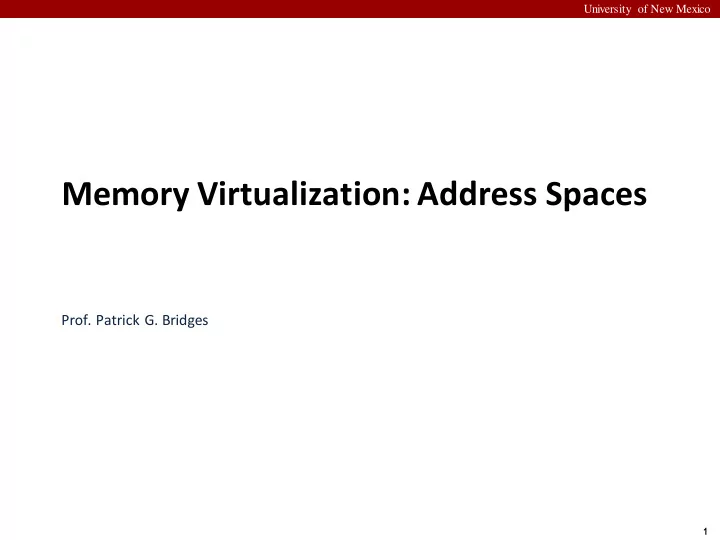

University of New Mexico Memory Virtualization: Address Spaces Prof. Patrick G. Bridges 1
University of New Mexico Memory Virtualization What is memory virtualization ? ▪ OS virtualizes its physical memory. ▪ OS provides an illusion memory space per each process. ▪ It seems to be seen like each process uses the whole memory . 2
University of New Mexico Benefit of Memory Virtualization Ease of use in programming Memory efficiency in terms of times and space The guarantee of isolation for processes as well as OS ▪ Protection from errant accesses of other processes 3
University of New Mexico OS in early eystems Load only one process in memory. ▪ Poor utilization and efficiency 0KB Operating System (code, data, etc.) 64KB Current Program (code, data, etc.) max Physical Memory 4
University of New Mexico Multiprogramming and Time Sharing 0KB Operating System Load multiple processes in memory. (code, data, etc.) 64KB ▪ Execute one for a short while. Free ▪ Switch processes between them in memory. 128KB Process C ▪ Increase utilization and efficiency. (code, data, etc.) 192KB Process B (code, data, etc.) 256KB Cause an important protection issue. Free ▪ Errant memory accesses from other processes 320KB Process A (code, data, etc.) 384KB Free 448KB Free 512KB Physical Memory 5
University of New Mexico Address Space OS creates an abstraction of physical memory. ▪ The address space contains all about a running process. ▪ That is consist of program code, heap, stack and etc. 0KB Program Code 1KB Heap 2KB (free) 15KB Stack 16KB Address Space 6
University of New Mexico Address Space(Cont.) Text/Data Program ▪ Where instructions and global variables live Text/Data Heap Heap ▪ Dynamically allocate memory. ▪ malloc in C language ▪ new in object-oriented language (free) Stack ▪ Store return addresses or values. ▪ Contain local variables arguments to routines. Stack Address Space 7
University of New Mexico Virtual Address Every address in a running program is virtual. ▪ OS translates the virtual address to physical address #include <stdio.h> #include <stdlib.h> int main(int argc, char *argv[]){ printf("location of code : %p\n", (void *) main); printf("location of heap : %p\n", (void *) malloc(1)); int x = 3; printf("location of stack : %p\n", (void *) &x); return x; } A simple program that prints out addresses 8
University of New Mexico Virtual Address(Cont.) Address Space 0x400000 Code The output in 64-bit Linux machine (Text) 0x401000 Data location of code : 0x40057d 0xcf2000 location of heap : 0xcf2010 Heap location of stack : 0x7fff9ca45fcc 0xd13000 heap (free) stack 0x7fff9ca28000 Stack 0x7fff9ca49000 9
Recommend
More recommend